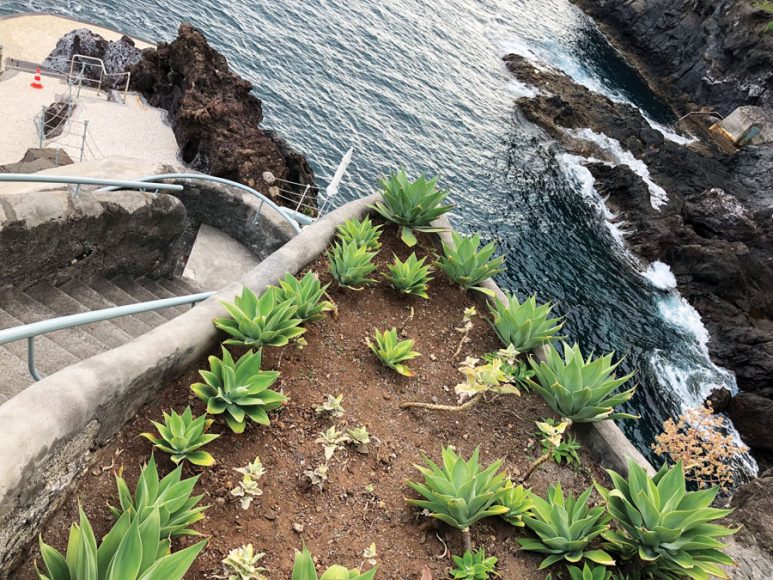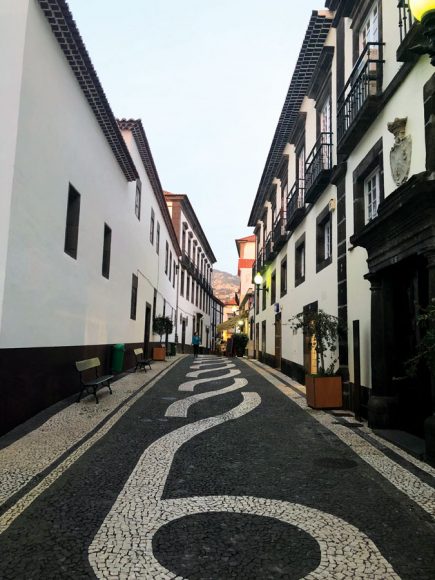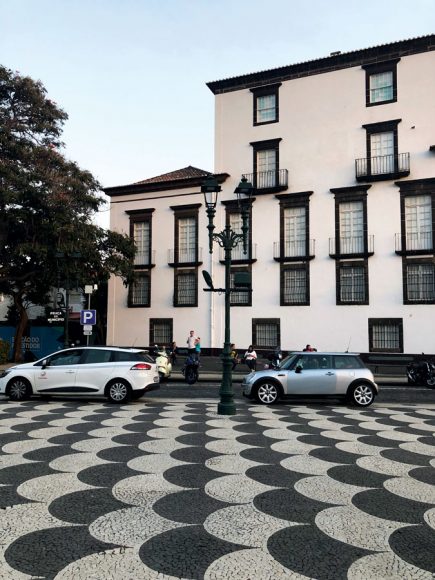I hadn’t realized that Madeira — a Portuguese archipelago in the North Atlantic — is best-known as the birthplace of Cristiano Ronaldo, the soccer player, nor that he was named after Ronald Reagan, his father’s favorite actor, Ronaldo being his middle name. But I could quite imagine that he comes second of all with his 116 million Instagram followers behind only Instagram itself.
The island is next best-known perhaps for its fortified wine. I developed a real liking for it, especially the Blandy’s 10 Bual. I found it a sweet, aromatic, sensual and complex wine, like Port with its inebriating potency. Blandy is a British-Madeiran dynasty like Reid, and it’s a name that appears behind much of the island’s commercial interests.
Meaning “fennel plantation” and very much the dominant center of the island, Funchal, the capital, is home to flower sellers obliged by law to wear their distinctive red-and-yellow-striped skirts along with a red bolero and a red cape. They certainly stand out in their famous “Festa da Flor” in May. It’s a highlight of the Madeira calendar and includes a children’s parade in which each child carries a single flower to put in a “Wall of Hope” in order to call for peace in the world.
I was to stay beyond Funchal’s main promenade at the magnificent salmon pink edifice known as Belmond Reid’s Palace. It belongs to an elite list of the world’s glamorous historic grand hotels, alongside London’s Ritz, Istanbul’s Pera Palace and Havana’s Nacional. It’s steeped in history with its many distinguished guests such as playwright George Bernard Shaw, who signed up for dancing lessons at the ripe old age of 71; Prime Minister Winston Churchill, who stayed in 1950 to write some of his memoirs, and by his presence gave the island a much-needed commercial boost; and Prime Minister Margaret Thatcher, who doubtless came for a much-needed break. And it was the choice of residence for Gen. Fulgencio Batista, the Cuban leader who was ousted in the 1959 Cuban Revolution. Afterward, he took the entire third floor of the hotel for his family and entourage of six bodyguards for the tidy sum of more than $20,000 a week in today’s money.
Funchal is like heaven on earth with a veritable garden of Eden, as it took me down its seductive cobbled paths full of exotic plants. I was stopped in my tracks by a purple and turquoise jade vine bud cascading from its branch that looked so unreal as to be fanciful. Every inch of space is clearly used to maximum effect with plants bearing fruits such as avocado, banana, papaya and orange.
If you’re the adventurous sort, then get a cable car all the way up to Monte from Funchal and then a toboggan ride halfway back down. Toboggan jockeys or sledge runners called “carreiros” take tourists on a 1.24 mile descent up to 30 mph in greased wicker baskets at a cost of $35. They’re dressed in white trousers, sport straw boaters and wear special shoes with rubber soles to give them traction and possess an attitude, like Venice’s gondoliers, that gives off an air of assurance and indifference.
With Atlantic Pearl, I boarded a catamaran to see the whales, dolphins and turtles out to sea. What a treat to experience the Atlantic waves before I strolled along the long promenade of the seafront to savor its winning combination of birds chirping and dogs barking. All generations were enjoying, in respectful harmony, their own preference for recreation — be it prams pushed, soccer balls kicked, lovers ambling, professionals on their mobiles, daddies relieving the mother’s duties, the retired pottering or the aged rickety on their feet. It was the seven ages of man in one fell swoop.
I then came to the Design Centre Nini Andrade Silva. Set high up on a second floor, it’s now a panoramic restaurant, both stylish and contemporary and acting as a cool backdrop to its warm staff. The brown, white and black décor was a pattern of monochrome that echoed some of the town’s Baroque squares, churches and civic buildings. The lights of the Funchal hills twinkled all around me and, with jazz tickling my ears and plump vast cushions propping me up, all my senses were engaged to prepare me for the taste of dinner to come.
Only 20 minutes from the airport and set beneath the city’s western escarpment, was my next place to stay, the Quinta Jardins do Lago.
The gardens have stems of tree ferns with names such as Dwarf Tree and Crocodile ferns; flowers such as Jade Vine, Black-Eyed Susan Vine, Golden Trumpet, Bleeding Glory bower and Corkscrew Flower; and succulents like Spanish Dagger, Blue Chalksticks and, amusingly, a Mother-in-Law’s Cushion.
The hotel’s heated swimming pool was lined with couples reading large printed paperbacks to be recycled, as is the trend, on the bookshelf by the pool. Chapters were being continued after dinner with a nightcap around the piano. Perhaps they had been persuaded to go for the excellent recent novels set on the island, including Lior Samson’s “Chipset,” Jim Williams’ “Tango in Madeira’ and Ann Bridge’s “The Malady in Madeira.” I was instantly enamored with the hotel’s 61-year-old mammoth tortoise, Colombo, who has roamed (and grown) freely ever since being let out of a previous owner’s son’s pocket on his way back from the Galapagos. When I say mammoth it actually takes four grown men to lift him.
His presence seems to sum up the quiet charm of this beguiling isle.
If you go:
For more on the island, I suggest Christopher Catling’s “Eyewitness Travel Top 10 Madeira” as the best guidebook. Though there are the inevitable imports to such a far-flung island, the food is locally sourced and so the cost of living to locals and tourists alike should prove reasonable. Don’t go expecting beaches or nightclubs but a serene lifestyle. For an even quieter time of things, check the weather before embarking on an ocean boat trip. The temperature is a steady 77 degrees Fahrenheit in summer and 62 in winter. However, the weather is changeable with clouds scudding by so I recommend taking a selection of lightweight clothes as it’s all about layers. And don’t drive around Funchal unless you’re fully briefed on directions as the steep narrow lanes can require you to reverse to let a school bus through when even a Smart car would be a squeeze.



